
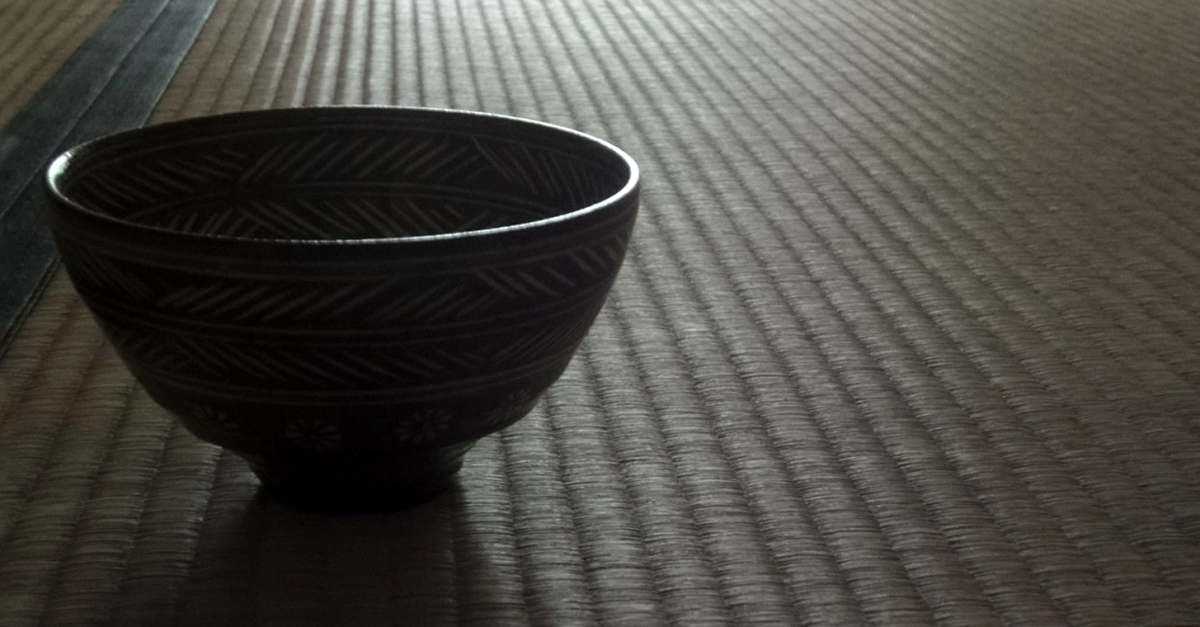
Teaching Tea: An Introductionby Michelle Liu Carriger & Rebecca Corbett
The term chanoyu literally means "hot water for tea." It's a deceptively simple name for a sprawling complex of practices, lore, and economic, artistic, and spiritual undertakings. Chanoyu is a plain, concrete name that describes an embodied practice of learning codified ways of serving and receiving food and drink, taught through in-person bodily transmission from teacher to student. Something so simple as participating in a set method of enjoying sweets, tea, and the artisan and artistic objects that accompany them has nevertheless amassed a vast archive of myths, histories, and aesthetic knowledges. Both within Japan and for foreign observers, Chanoyu has been alternately venerated as the quintessence of Japanese culture or denigrated as a terribly conservative and old-fashioned pastime for a select few. In the twentieth and twenty-first centuries, chanoyu began to be promulgated outside Japan as a spiritual and mindful practice, and it has since found a comfortable home among health fads for matcha as a "superfood" and the bottomless global appetite for discovering mindfulness practices to help improve wellbeing against the drain of modern life. With all of these complex desires and details in the air, it can be hard to have a clear sense of what chanoyu is, how it functions in the present and the past, and what it means for national/cultural Japanese identity, individual and collective peacefulness practice, and/or health and wellbeing. Over our years as students of the embodied practice of chanoyu and as scholars researching it, we've seen how difficult it can be to get a clear and accurate understanding of something so nebulous and sprawling.
The Teaching Tea project came out of our shared desire to help make better introductory materials available for people interested in chanoyu and those responsible for teaching it in academic settings. Our goal is to help demystify chanoyu. We want to avoid admiring, but orientalizing, approaches but also fairly represent the complex details that make chanoyu into a lifelong, connoisseur practice with a rich history and vocabulary of its own. In the remainder of this short introduction to the project, we discuss basic terminology, describe how chanoyu persists today, and trace a very short history of how it got to the twenty-first century.
Terminology
In English, the term "tea ceremony" has been widely used since the late nineteenth century when writings about Japanese culture in English began in earnest. For some scholars and practitioners, "tea ceremony" is a misnomer that conjures up religious or spiritual connotations, suggests there is a viewing audience rather than a group of practitioners all participating in the event, and is not a direct translation of any Japanese term. If we were to re-translate "tea ceremony" into Japanese, we would get "cha-shiki," a term that does not exist and would seem perplexing to any Japanese speaker. It seems that in its earliest uses, "tea ceremony" was describing what in Japanese are called "temae," a term that most scholars would instead translate as "tea making procedures" or "procedures for making tea." These tea making procedures make up part of the practice of chanoyu but not the entirety of it. One reason therefore for the preference of using chanoyu among some contributors to this project is that these tea-making procedures are only part of the entire culture and practice we are speaking of, and chanoyu is a term that encompasses this breadth and depth. In the materials available here, contributed by different scholars with differing viewpoints, the contributors may refer to "chanoyu" or to "tea ceremony" or to "Tea" with a capital T to indicate that they are speaking about a complex of embodied practices, rather than "tea," a specific botanical substance or beverage.
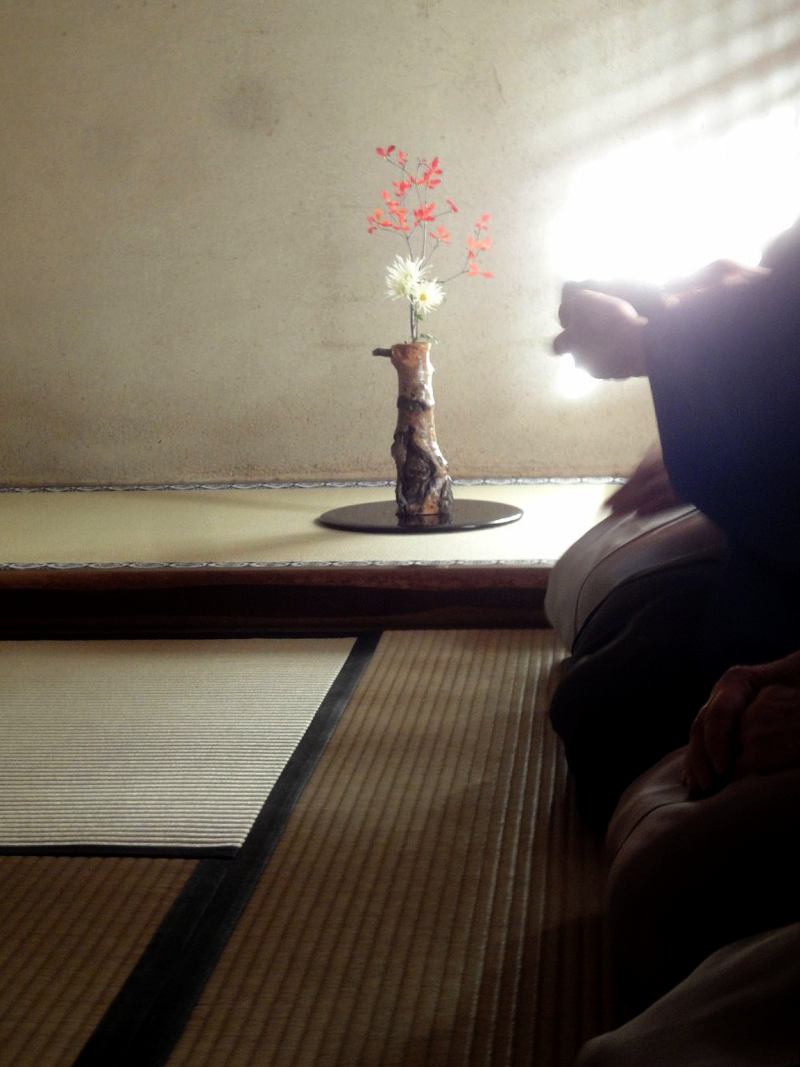
Matcha
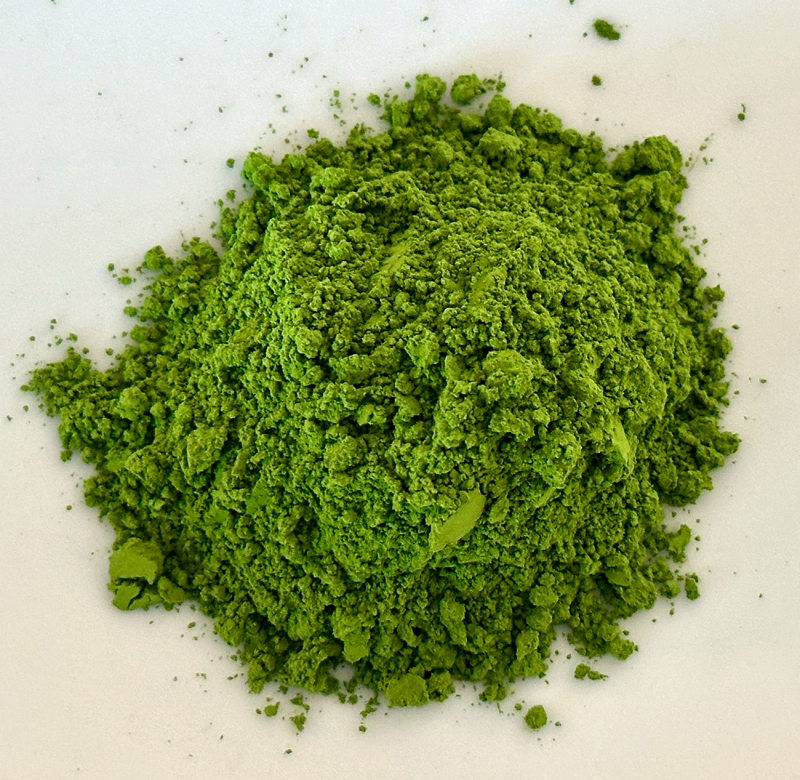
The entire culture and history of chanoyu is based on the preparation and consumption of only one kind of tea: matcha. Matcha is powdered green tea which comes from the same plant that gives us all black, green, and white teas: camelia sinensis (the "tea plant"), which is part of the camellia family. In making green tea, the leaves of the plant are steamed to prevent oxidation (this is why they stay green rather than turning brown) and then dried. To create matcha, the leaves are then de-stemmed, crushed, and ground to a powder, typically using a stone grinder. It is this powder that is then whisked into hot water to create a beverage, and this is a key point of difference with other varieties of green tea, as well as white and black teas, in which the tea leaves are steeped and then removed (either by a tea bag being taken out or by the leaves being strained), and the hot water that remains is drunk. In consuming matcha you are actually ingesting the tea leaf itself.
Matcha is far from being the only, or even close to being the most popular tea in Japan—those would be steeped teas, as is also most common in China, Europe, and the rest of the world. Matcha is an antiquated form of tea preparation that was kept alive solely through the practices of chanoyu until it was "discovered" as a superfood in recent years. Today, matcha's popularity is no longer attached to the perpetuation of the schools of chanoyu practice since it is easily found in cafes and grocery stores both in Japan and around the world. The connection, however, remains apparent in the branding of many varieties of matcha as "ceremonial grade" (harkening back to the term "tea ceremony"), which simply means that it is of a high enough standard for drinking, as opposed to cooking grade matcha. Meanwhile, while they are no longer the sole market for matcha, the schools maintain and perpetuate many other cultural and artistic ideas that make up the practice of chanoyu, both for their "insider" participants and for the larger society in Japan and beyond.
History
Chanoyu developed in the sixteenth century, a new cultural practice led by merchant tea masters working for powerful military and political figures in dialogue with other sophisticated cultural and social practices, like Zen, calligraphy, poetry, and Noh theatre. While it was a new practice, it grew out of existing practices for preparing and drinking matcha that had originated many centuries earlier in China and been transmitted to Japan. Key differences that emerged in the sixteenth century codification of chanoyu as a distinct cultural and artistic practice were an emphasis on incorporating locally made Japanese objects alongside older Chinese pieces, an emphasis on rusticity, and the formalization of positions for tea masters as cultural advisors to powerful political figures. By the seventeenth century, descendants and students of these early tea masters began to establish lineages and formal schools of practice which enrolled students in formal curriculums of study; many of these schools still exist today. Throughout the eighteenth and nineteenth centuries, in what historians call the early modern period, more and more people began studying chanoyu, and more information about it became widely available through publications. From the late nineteenth and into the early twentieth century, chanoyu came to be associated with traditional Japanese culture, in contrast to "modern Western culture." Although the image of a "traditional cultural practice" might make us think of something static and unchanging, in fact, chanoyu has continued to evolve throughout the centuries.
Over the last four hundred years, chanoyu has been popular among certain groups of people, for different reasons. In the sixteenth century, military and political figures learned the practice, collected tea utensils such as tea bowls and ceramic containers for thick tea, and hosted tea gatherings at least in part as a way to demonstrate their wealth and power. Sometimes after a victorious battle they would send their vassals into the ruins of their enemies' castles to collect their tea utensils and, if broken, have them repaired. We know of a particularly famous example of this when the warlord Tokugawa Ieyasu 徳川家康 (1543–1616) sent his forces into the ruins of Osaka Castle in 1615 to collect objects, including tea containers, owned by his defeated enemies, the Toyotomi family. Thanks to modern x-ray technology, we can see how several ceramic tea containers for thick tea were repaired for use.
In the eighteenth century, women from commoner families were encouraged to learn chanoyu as a way of studying etiquette and comportment. Learning tea was one of the ways a woman could display her cultural accomplishments at an interview to gain a position in service at an elite household.
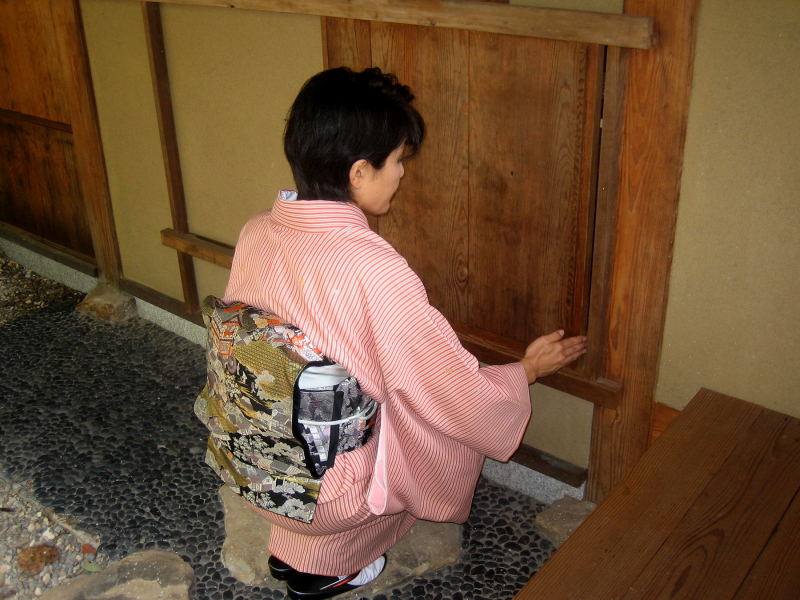
Zen Buddhism
Chanoyu can also be a Zen practice. Many of the early tea masters in chanoyu were Zen priests, alongside their work as merchants and cultural advisors. There are a lot of ways in which we can find the influence of Buddhism, particularly Zen, in chanoyu tea culture. An obvious example is the choice to hang calligraphy phrases in the alcove (tokonoma) of a tea room, which guests view upon entering the room and know that the host has chosen to set the tone for their specific gathering. These pieces of calligraphy are almost always brushed by a Zen priest or tea master with Zen training, and they typically deploy a Zen phrase. For example, "Pointing to the Moon" on the scroll on the scroll in figure 3, which references a Zen phrase commonly used as a reminder not to be too attached to words and/or teachings and not to confuse either with what they are pointing to: "The teachings are like a finger pointing to the moon, don't confuse the moon with the finger."
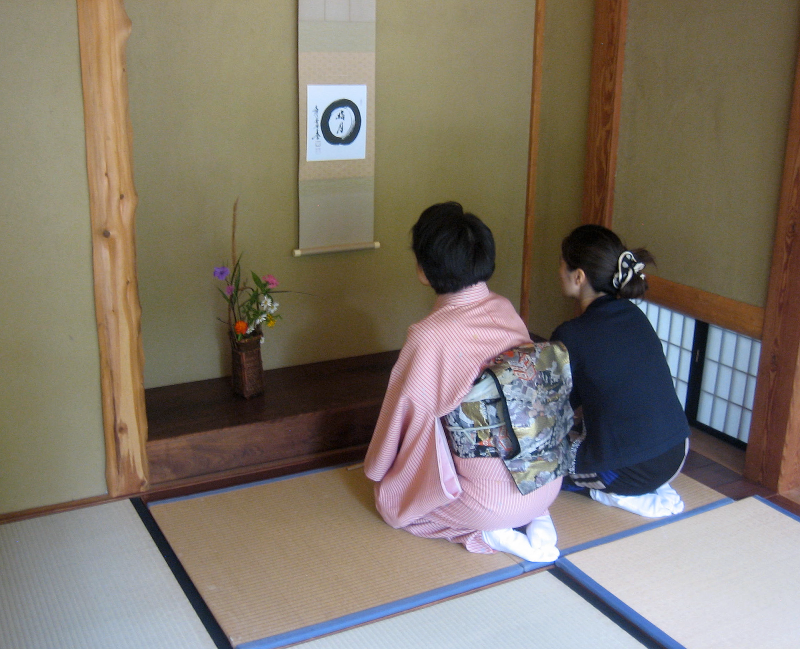
While we may associate Zen with meditation, or mindfulness, Zen does not ignore the physical world or attempt to master it or deny it. In fact, the discipline associated with a physical practice, such as chanoyu, together with a cultivation of aesthetic sensibility can be what leads to a transformation in awareness. One of the more famous teachings of an early tea master is, "Just heat water and make tea. This is all you need to know."
Contemporary Practice
Chanoyu today persists primarily as a result of the establishment of a number of schools of tea (about twelve to twenty or so of various sizes) that are primarily arranged hierarchically from the most junior of students up to the "head" (iemoto) of each school, who is usually a son of the previous head. Familial arrangements for the perpetuation of traditional arts is very common in Japan, and chanoyu families share this mode with many artisans and performing artists. The most populous of these schools of tea today is Urasenke. It is one of three schools that are branches of the Sen family line, who trace their lineage back to an early tea master, Sen no Rikyu 千利休 (1522–1591), who is often venerated as the "founder" of chanoyu, but we suggest is best thought of as the most articulate and well known of a number of merchant tea masters active in the city of Sakai when the practice of chanoyu was coalescing in the sixteenth century. Although the Urasenke school is today the largest tea school, both in Japan and internationally, this is the result of their having most successfully navigated the twentieth century. Historically, other schools of tea were more prominent. Since the Urasenke school is the largest today and has branches worldwide, it is the school that most English-speaking academics who have studied Tea (including most of the contributors to this project) belong to, and it is the school that most writings in English reflect. Furthermore, even in Japan and in Japanese, Urasenke runs a full publishing house called Tankosha that also helps to maintain Urasenke's prevalence in Japanese-language publications as well. The Teaching Tea project strives to reflect all schools of Tea and minimize Urasenke bias, but it is inevitable that some will creep in and readers should keep this in mind. Throughout this project, wherever possible, if there are differences among schools on a certain subject, we will point this out.
Keiko
So how does someone become a "tea person" (chajin 茶人)? Today, tea practitioners come to the practice for a variety of reasons, such as: they like eating Japanese sweets and drinking matcha; they are interested in traditional Japanese culture; they are interested in Zen Buddhism; other generations of their family have practiced. Some people begin taking lessons in chanoyu as part of a club at their school, university, or even workplace, but most people, both inside and outside Japan, enroll in lessons with a private teacher who holds classes in their home or a community center. Through their teacher they become registered with the school's headquarters, most of which are in Kyoto, but there are schools headquartered in other parts of Japan. In a large school like Urasenke, a student has layers of relationships that develop through their practice of chanoyu: first, with the other members in their group (known as a shachū) who all study with the same teacher; then, via the association that is formed between all of the teachers belonging to the same school in a city or region; and finally, to the school itself. In smaller schools, such as Ueda, a student may study directly with the head of the school.
Typically students attend lessons once a week and begin learning the basic ways of handling certain utensils, such as a bamboo whisk (chasen), silk folding cloth (fukusa), and container for thin tea (natsume or chaki), before beginning to learn procedures for making tea. Most of today's schools of tea teach a curriculum that begins with very simple procedures that may take as little as ten to fifteen minutes in duration, and, as students progress, more complex procedures and variations are taught. Within each school of tea there are hundreds of procedures (temae) that vary according to the season, the utensils being used, and the level of formality. To give some examples, the tea calendar is divided into summer and winter seasons (furo and ro for the type of heating source used), with the placement of utensils, as well as style of utensils, being different in each. For each tea-making procedure, a student learns both the summer and winter variations, as well as additional variations which happen only in summer or winter. Then there are the tea-making procedures for making thick tea, which are more formal, and thin tea, which are less formal, with each requiring the use of specific utensils that the student learns how to handle. What most people involved in chanoyu do most of the time is attend classes (keiko), but the point of all this study is to put the learning into practice in the form of hosting or being a guest at a tea gathering.
Chaji
In a formal tea gathering, called a chaji, the guests (typically up to five) are greeted at a waiting bench in the garden, enter the teahouse through a small crawl-through door, and view the hanging scroll. A multi-course meal (called kaiseki) is served with each course prepared and presented according to certain rules (for example, one course has to be a grilled item; another course has to have something from the mountains and something from the sea). Sake is also served, followed by a sweet.
Either before or after the meal, depending on the season, charcoal is laid to kindle the fire under the water kettle, another specific procedure that students learn in practice. The guests then retire to the garden while the host refreshes the tea room and prepares to serve the tea. Once the guests are invited to return, the host prepares thick tea (koicha) in one bowl for all the guests to share. A second charcoal laying procedure banks the fire. Finally, the host brings in more sweets, usually smaller and lighter than the first offering, before preparing thin tea (usucha). This is the most informal and relaxed part of the tea gathering; it is usually the only part that we demonstrate publicly or invite non-tea students to watch or participate in (not because of any taboo against other parts of the practice being shown, but because of the length and complexity of those procedures means they can be difficult for the uninitiated to appreciate or engage in meaningfully).

There are also other tea making procedures that we might use outside the context of a formal tea gathering. These include outdoors picnic-style tea making procedures where everything is stored inside a box specially designed to hold tea utensils (chabako) and very casual and quick tea making procedures where all of the utensils are placed on a small tray (bonryaku), which can be performed anywhere—even at the beach or in a park! This short tea making procedure using a tray is usually the first procedure students learn, and it takes about fifteen to twenty minutes. By contrast, a more formal procedure that is part of the secret/inner teachings (okuden) that a student might begin learning only after one or two decades of chanoyu study may take forty-five minutes or more.
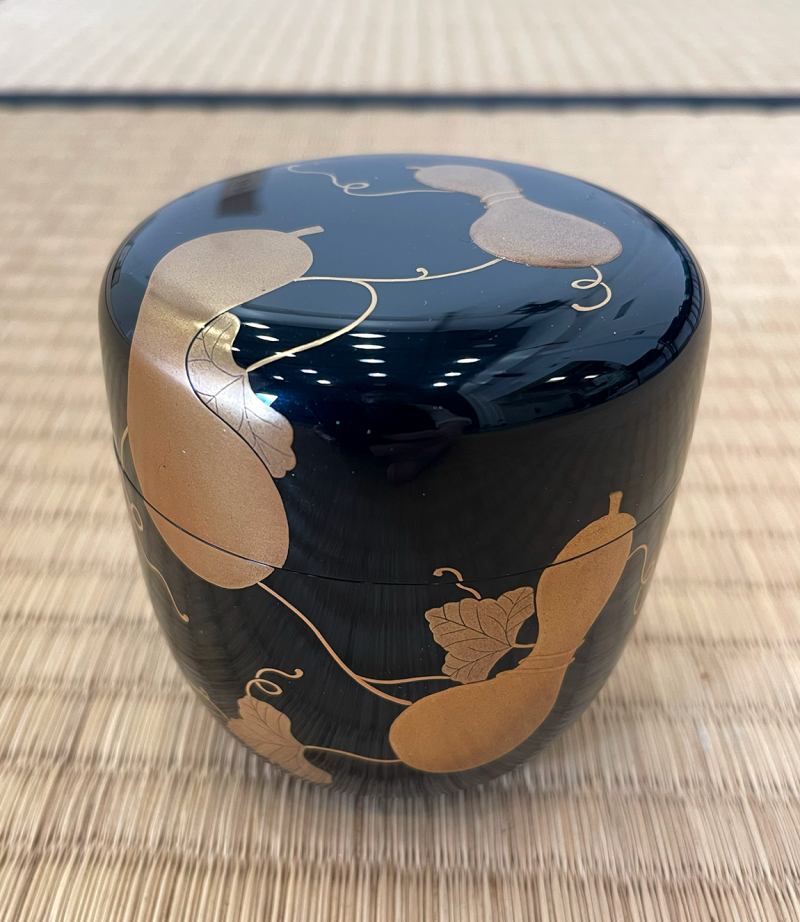
Chanoyu can be thought of as an art of social interaction based around the appreciation of aesthetics, art objects, and the consumption of matcha, food, and sweets. For a tea gathering to flow smoothly and function at its optimum level, both the host and the guests must be knowledgeable in the practice, know the rules, and have a shared understanding of the aesthetic principles underpinning the practice. When this is the case, non-verbal communication can be as powerful as speech. To give an example, the Japanese word for "six gourds" is a homophone for "no disease" (mubyo), so when a guest sees a utensil that has three gourds as part of its design come out early in the tea gathering, they may instinctively be on the lookout for the remaining three gourds that may appear later in the tea gathering on another item, perhaps even in a subtle way. This kind of playful "guessing game" could be used by the host to send a message of longevity and good health to the main guest, or to all of the guests, on an auspicious occasion such as the main guest's 80th birthday.
Chanoyu is a practice that rewards connoisseurship, like many other traditional arts, or even sports and movies. While anyone might watch a ballet or enjoy a professional sports game without prior knowledge, ballet aficionados gain additional pleasure from seeing the same dancers in different roles, or the same ballet done by different companies. Similarly, a sports fan can talk about favorite players, stats, previous years' games, and extensive additional information that deepens and broadens their appreciation.
For Tea connoisseurs, one of the ways they extend their engagement in the event of tea making is through appreciation of toriawase, the act of combining the various utensils or objects in the tearoom. Through careful selection and skillful deployment, a host can convey messages, themes, or feelings to their guests. The guests in turn need to have enough knowledge to read this message, or to tease it out through dialogue with the host. Indeed, much of the conversation within a tea gathering is centered around the objects being used. The main guest, seated first among the order of guests, has the responsibility of leading conversation with the host. On their own behalf, or for the benefit of the other guests, they may offer comments or ask questions about the hanging scroll (What does it say? Who brushed it?), the tea bowl (Who is it made by? What kiln is it from?), the ceramic tea container (What is the name of the shape? What kiln is it from?), the silk pouch holding the ceramic tea container (What is the name of the fabric pattern? Who made it?), the tea scoop (Does it have a poetic name? Who carved it?), and so on. They will also ask about the name of the matcha and the farm it comes from, as there are countless different blends of matcha produced by different plantations, and a discerning palate can taste the differences. Within a tea gathering, a different blend of matcha will be used for the thick tea and thin tea preparations too.
Creative Expression
One of the things many practitioners enjoy about chanoyu is that it is a vehicle for creative expression once you know the rules enough to bend, break, and play with them. To give a historical example, Tagami Kikusha 田上菊舎 (1753–1826) was a woman who after being married and widowed young, took the tonsure and became an itinerant nun, traveling all over the main and south islands of Japan over a thirty-year period. She wrote a poetic travel diary, composed poetry in a variety of genres, brushed paintings and calligraphy to accompany her poems, played musical instruments, and practiced chanoyu. She also made her own utensils for use in chanoyu, including tea bowls and tea scoops. One of these tea scoops is called Idesoyo. Written on one of its storage boxes is the name of the scoop, Idesoyo, and the words "made by myself using bamboo from Ina." Written on the other box is her pen name, Ichijian, and the following verse:
It is as if the rustling grasses whisper,
I will be steadfast here
at Mount Arima
This haiku alludes to an early eleventh-century poem from an anthology of classical poetry:
Near Arima Hill
the wind through Ina's bamboo
blows constantly
and just as constant am I
in my resolve not to forget
In her verse, Kikusha borrows three words from the classical poem —"rustling," "steadfast," and "Mount Arima"—in addition to using bamboo from Ina (a place referenced in the classical poem) as the material for the scoop. The allusion would have been immediately recognizable to readers or listeners in Kikusha's day as the One Hundred Poems by One Hundred Poets (Hyakkunin isshū 百人一首) anthology was widely used as an educational text. The Idesoyo tea scoop reveals how Kikusha expressed her identity as a poet, calligrapher, and cultural connoisseur through chanoyu.
To give a contemporary example from Los Angeles, a faculty, student, and alumni team at UCLA launched Teahouse with Pacific Plastics in 2024. Made entirely out of sustainable and upcycled materials, with an ocean theme drawing attention to the Great Pacific Garbage Patch as well as transpacific cultural connections between Japan and the U.S., many of these tea utensils were specially commissioned for this project, including a tea scoop made of heat fused recycled plastic bags, a lid rest 3D printed from recycled plastic bottles (in place of the typical piece of bamboo), and a series of unique bowls created by a local potter and inspired by Kumamoto oysters (oysters once native to Kumamoto on the south island of Japan that were brought to the U.S. in the postwar period, wiped out in Japan after an environmental disaster involving mercury poisoning and now only preserved on the West Coast of the U.S.). There are also a lot of found and repurposed objects given new life through the tea space, such as the old buoy atop a fishing basket used for displaying flowers and the kimono fabric scraps used for the tatami borders. This is a tea house and assemblage of utensils designed to convey a message to visitors, expressed through creative and deeply thought adaptations of "traditional" utensils.
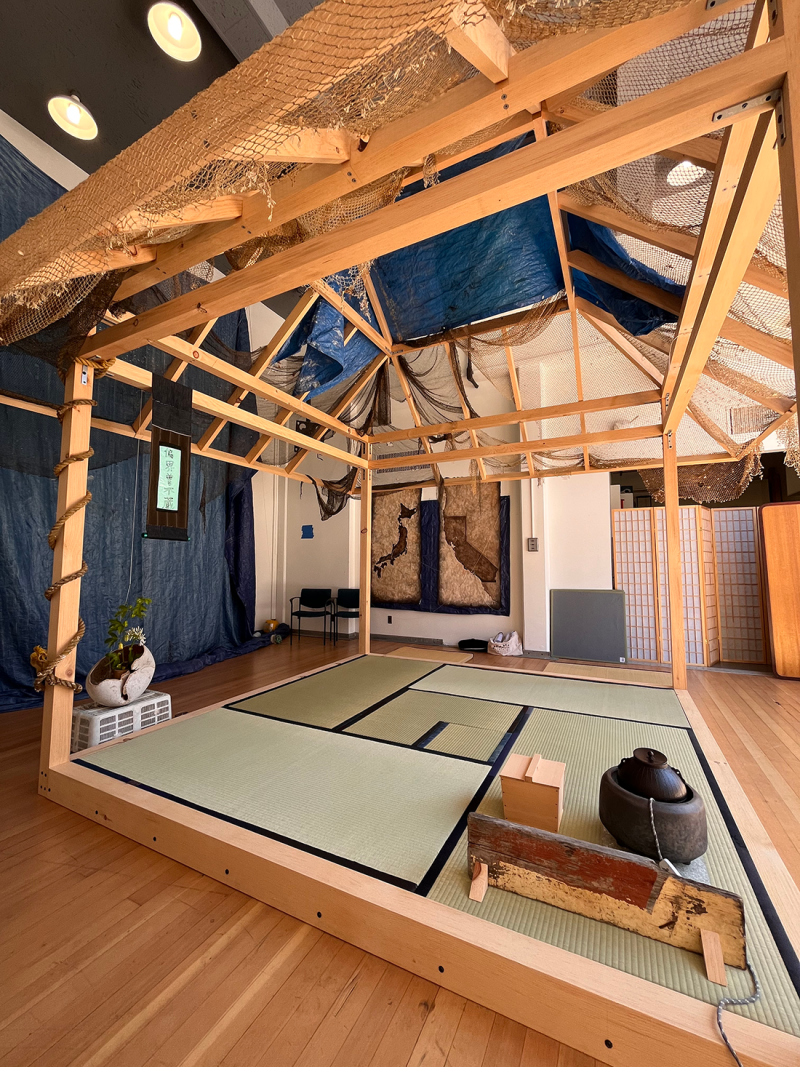
Paths Forward
It is part of the paradox of chanoyu that something so simple as just "heating water and making tea" can be the basis of so many myths and histories, encouraging those who encounter the practice to consider art, architecture, nature, history, spirituality, society, culture, and nationality. Chanoyu can be Art; it can be an embodied practice, a spiritual practice, a social practice with friends, or really anything the practitioner/s themselves want it to be. For most, but not all, practitioners, it is a lifelong path of study. Chanoyu is crucial to understanding Japanese history and art history since the late 1500s. It is also central to the way Japan has positioned itself and been understood globally since the twentieth century. We hope that Teaching Tea demystifies and deepens students' and teachers' understanding, offering multiple points of entry and numerous paths through the world of chanoyu knowledge and practice.
Teaching Tea is an ongoing collaborative project which will continue to grow. We hope that the essays, lesson plans, media, vocabulary, and reading lists that we have created will be of use for students and teachers alike.
To cite this page:
Carriger, Michelle Liu, and Rebecca Corbett. "Teaching Tea: An Introduction." Teaching Tea: Culture, History, Practice, Art on Japan Past & Present. 2025. https://japanpastandpresent.org/en/projects/teaching-tea-culture-history-practice-art/introduction/teaching-tea-an-introduction